Rainfall-Induced Landslide Susceptibility Assessment and the Establishment of Early Warning Techniques at Regional Scale
Abstract
:1. Introduction
2. Literature Review
2.1. Landslide Detection
- (1)
- Data Collection: This includes gathering historical landslide records, weather data, seismic data, and satellite imagery. Synthetic Aperture Radar (SAR) data are particularly valuable due to their ability to penetrate through cloud cover and the ability to collect data regardless of weather conditions or daylight [7,8,9].
- (2)
- (3)
- Topographic and Geological Analysis: Analyzing digital elevation models (DEMs) to assess the slope, aspect, and curvature of the terrain, as well as studying geological maps to understand the lithological aspects of the region [10].
- (4)
- Creation of Baseline Inventory Maps: Using past landslide inventories to create baseline maps that help in identifying changes and predicting future landslide-prone areas.
- (5)
- (6)
- Transferability Evaluation: For methods utilizing machine learning, this involves assessing the transferability of models trained on data from different regions (such as other parts of Taiwan, China, or Japan) to the area of study [11].
- (7)
- Ground Truthing and Validation: Conducting field surveys to validate and refine the results obtained from remote sensing and image analysis [12].
- (8)
- (9)
- Literature Review: Reviewing the existing literature and methodologies to ensure that the study is building on the state of the art and to acknowledge the work that has contributed to the understanding and technology of landslide detection.
2.2. Landslide Prediction and Hazard Analysis
3. Modeling the Study Region
3.1. Selection of Study Area
3.2. Model Parameter Processing
3.2.1. Soil Slope and Thickness
3.2.2. Groundwater Depth and Flow Direction
3.2.3. Soil Parameter Processing
3.2.4. Execution Process of the TRIGRS Model for Slope Stability
3.3. Calibration of Rainfall Data
3.4. Suitability Assessment of Alert Thresholds: Rainfall Data Case Study
4. Analysis and Evaluation of Landslide Area
4.1. Model Calibration
4.2. Thresholds for Landslide Warnings
4.3. Cumulative Rainfall Thresholds for Landslide Warnings
4.3.1. Assessment Results of Cumulative Rainfall Warning
4.3.2. Comparisons of Slope Warning Cumulative Rainfall
4.4. Evaluation of Thresholds for Early Warnings
4.4.1. Evaluation of Thresholds for Early Warnings: Case Study
4.4.2. Comparison with Previous Research Findings
5. Conclusions
- This study employs a rate-based method to simulate and compare rainfall-induced landslides with actual events, determining village-specific red and yellow warning thresholds. By applying design rainfall patterns, village-level cumulative rainfall values are calculated to guide landslide warnings, enhancing the disaster response.
- The proposed method surpasses traditional statistical approaches by incorporating local geophysical data, reducing unnecessary evacuations and aiding in disaster management planning and budgeting based on single historical events per village.
- The study’s warning values correlate with existing thresholds set by the SWCB and NCDR, offering a median 6 h response window, thus validating its utility for typhoon-related landslide alerts.
- Considering the response times for emergency procedures, the study’s red and yellow warnings enable proactive landslide alerts, allowing the timely deployment of resources and evacuations, with the physical model providing a detailed safety factor distribution for improved alert precision.
- Merging the research outcomes with live rainfall data and updates from the Meteorological Bureau enhances the identification of critical areas, supports simulations of slope behavior under rainfall, and provides benchmark data for future landslide guidelines and interventions.
- Integrating the findings with local geology offers invaluable insights for government entities in refining Landslide Hazard Maps and aids grassroots units in Regional Disaster Prevention Map production.
Funding
Institutional Review Board Statement
Informed Consent Statement
Data Availability Statement
Acknowledgments
Conflicts of Interest
Appendix A
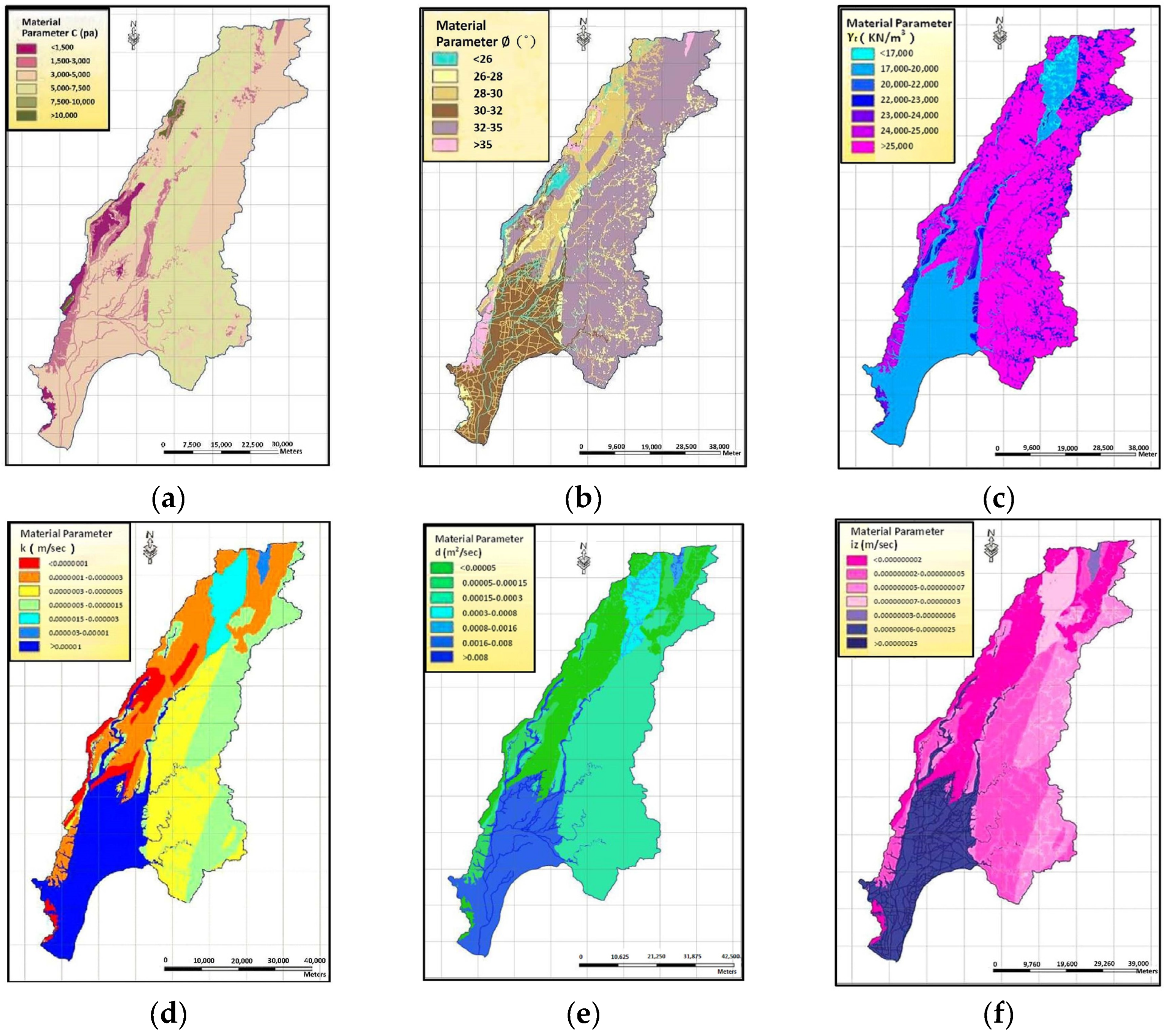
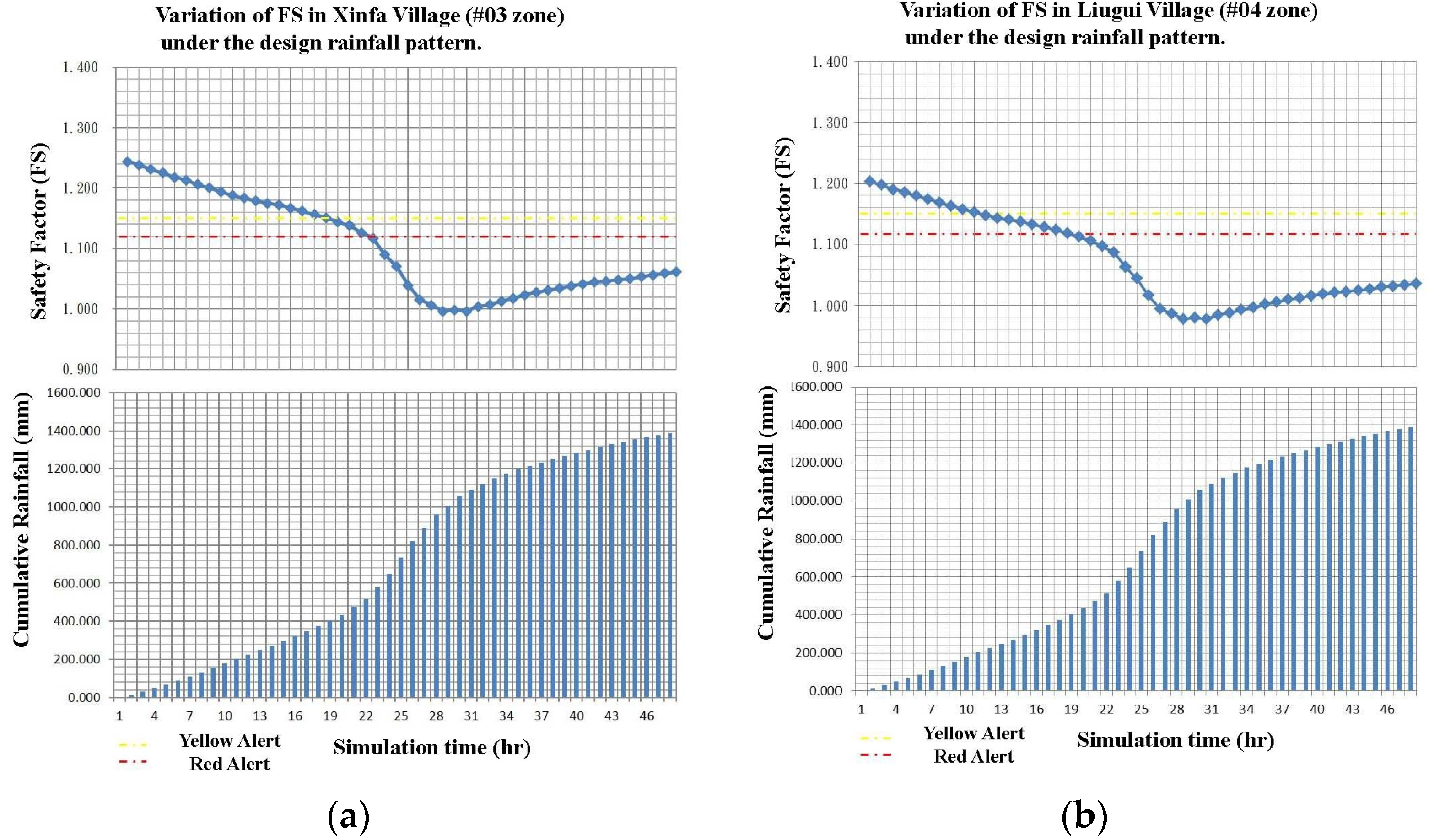
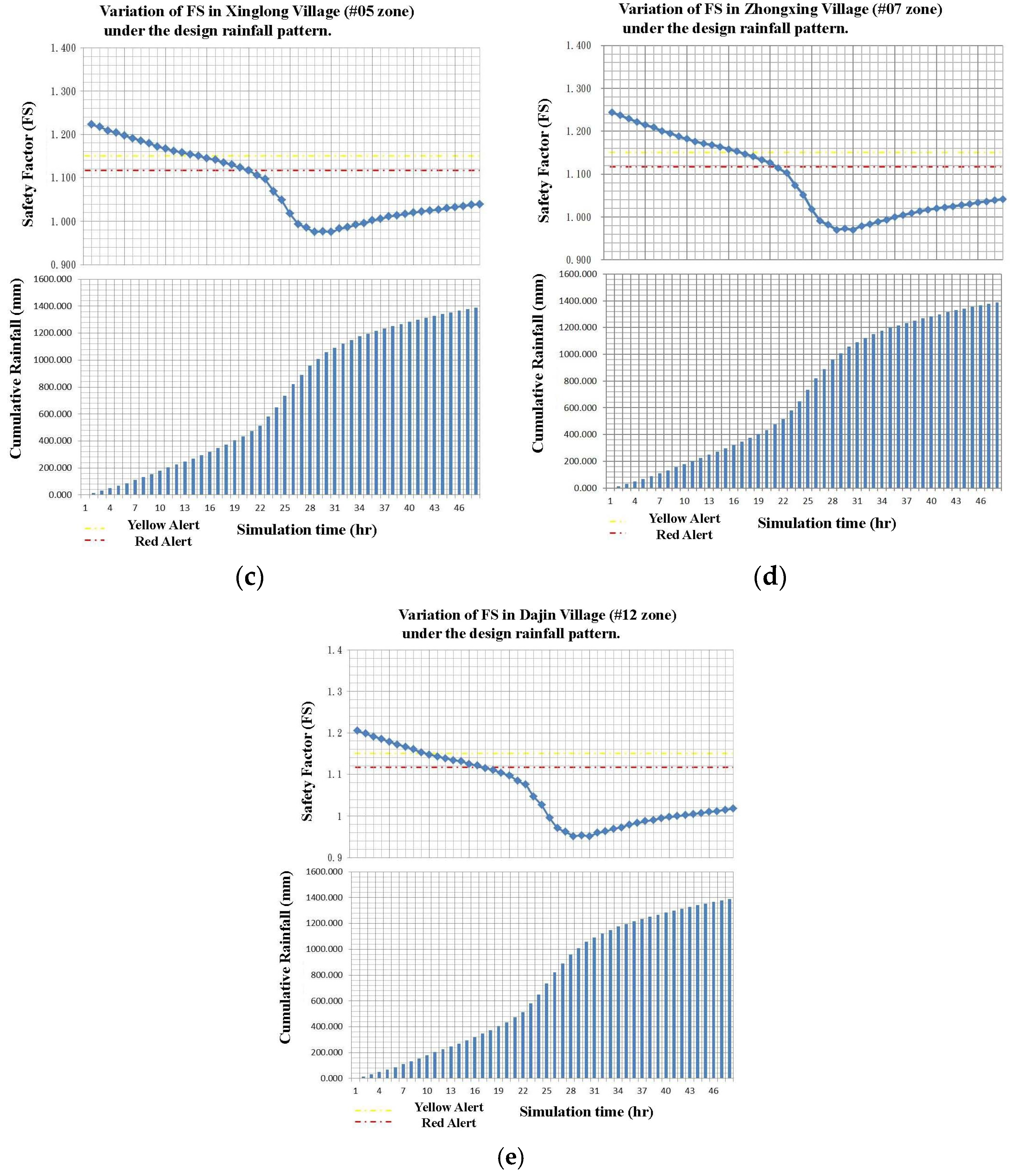
References
- Chien, L.-K.; Hsu, C.-F.; Yin, L.-C. Warning Model for Shallow Landslides Induced by Extreme Rainfall. Water 2015, 7, 4362–4384. [Google Scholar] [CrossRef]
- Sinotech Engineering Consultants, Inc. Geological Survey and Database for Upstream Watersheds of Flood-Prone Areas (Phase 2, 2009)—Effect of Hydrogeology on Slope Stability (2/3) Result Report; S.E.C. Inc.: Taipei, Taiwan, 2009. [Google Scholar]
- Chung, M.C.; Tan, C.H.; Chen, M.M.; Su, T.W. Deterministic approach for estimating critical rainfall threshold of rainfall-induced landslide. In Proceedings of the Annual Meeting and Academic Seminar of the Chinese Society of Soil and Water Conservation, Taichung, Taiwan, 7 December 2011. [Google Scholar]
- Huang, S.W. Vulnerability Assessment of Rainfall-Induced Shallow Landslide under Extreme Climate; National Taiwan Ocean University: Keelung, Taiwan, 2012. [Google Scholar]
- NCDR. National Science and Technology Center for Disaster Reduction. 2014. Available online: http://satis.ncdr.nat.gov.tw/dmap/102rule.aspx (accessed on 10 October 2023).
- SWCB. Soil and Water Conservation Bureau, Council of Agriculture (COA), Executive Yuan. 2014. Available online: http://246.Swcb.Gov.Tw/index.Html?Pk=7cc09f308450a08a0b73ae712a5275ae (accessed on 10 October 2023).
- Huang, M.-H.; Hu, J.-C.; Ching, K.-E.; Rau, R.-J.; Hsieh, C.-S.; Pathier, E.; Fruneau, B.; Deffontaines, B. Active deformation of Tainan tableland of southwestern Taiwan based on geodetic measurements and SAR interferometry. Tectonophysics 2009, 466, 322–334. [Google Scholar] [CrossRef]
- Deffontaines, B.; Chang, K.-J.; Champenois, J.; Fruneau, B.; Pathier, E.; Hu, J.-C.; Lu, S.-T.; Liu, Y.-C. Active interseismic shallow deformation of the Pingting terraces (Longitudinal Valley–Eastern Taiwan) from UAV high-resolution topographic data combined with InSAR time series. Geomat. Nat. Hazards Risk 2017, 8, 120–136. [Google Scholar] [CrossRef]
- Tsukahara, K.; Takada, Y. Aseismic fold growth in southwestern Taiwan detected by InSAR and GNSS. Earth Planets Space 2018, 70, 52. [Google Scholar] [CrossRef]
- Chang, K.-T.; Merghadi, A.; Yunus, A.P.; Pham, B.T.; Dou, J. Evaluating scale effects of topographic variables in landslide susceptibility models using GIS-based machine learning techniques. Sci. Rep. 2019, 9, 12296. [Google Scholar] [CrossRef]
- Ghorbanzadeh, O.; Crivellari, A.; Ghamisi, P.; Shahabi, H.; Blaschke, T. A comprehensive transferability evaluation of U-Net and ResU-Net for landslide detection from Sentinel-2 data (case study areas from Taiwan, China, and Japan). Sci. Rep. 2021, 11, 14629. [Google Scholar] [CrossRef] [PubMed]
- Shahabi, H.; Rahimzad, M.; Tavakkoli Piralilou, S.; Ghorbanzadeh, O.; Homayouni, S.; Blaschke, T.; Lim, S.; Ghamisi, P. Unsupervised Deep Learning for Landslide Detection from Multispectral Sentinel-2 Imagery. Remote Sens. 2021, 13, 4698. [Google Scholar] [CrossRef]
- Ghorbanzadeh, O.; Gholamnia, K.; Ghamisi, P. The application of ResU-net and OBIA for landslide detection from multi-temporal Sentinel-2 images. Big Earth Data 2022, 1–25. [Google Scholar] [CrossRef]
- Lacroix, P.; Bièvre, G.; Pathier, E.; Kniess, U.; Jongmans, D. Use of Sentinel-2 images for the detection of precursory motions before landslide failures. Remote Sens. Environ. 2018, 215, 507–516. [Google Scholar] [CrossRef]
- Manasi, P.; Rojasree, G.; Jahnavi, G.; Yojitha, U.; Saha, A.; Pal, T. U-Net Deep Neural Network-Based Landslide Detection Method. In Proceedings of the Intelligent Systems and Sustainable Computing, Hyderabad, India, 16–17 December 2022; Springer Nature: Singapore, 2023; pp. 469–477. [Google Scholar]
- Ghorbanzadeh, O.; Xu, Y.; Zhao, H.; Wang, J.; Zhong, Y.; Zhao, D.; Zang, Q.; Wang, S.; Zhang, F.; Shi, Y.; et al. The Outcome of the 2022 Landslide4Sense Competition: Advanced Landslide Detection From Multisource Satellite Imagery. IEEE J. Sel. Top. Appl. Earth Obs. Remote Sens. 2022, 15, 9927–9942. [Google Scholar] [CrossRef]
- Schilirò, L.; Montrasio, L.; Mugnozza, G.S. Prediction of shallow landslide occurrence: Validation of a physically-based approach through a real case study. Sci. Total Environ. 2016, 569, 134–144. [Google Scholar] [CrossRef] [PubMed]
- Medina, V.; Hürlimann, M.; Guo, Z.; Lloret, A.; Vaunat, J. Fast physically-based model for rainfall-induced landslide susceptibility assessment at regional scale. Catena 2021, 201, 105213. [Google Scholar] [CrossRef]
- Bulzinetti, M.A.; Segoni, S.; Pappafico, G.; Masi, E.B.; Rossi, G.; Tofani, V. A tool for the automatic aggregation and validation of the results of physically based distributed slope stability models. Water 2021, 13, 2313. [Google Scholar] [CrossRef]
- Lambe, T.W.W.; Whitman, R.V. Soil Mechanics; Wiley: New York, NY, USA, 1979; p. 553. [Google Scholar]
- Jibson, R.W.; Harp, E.L.; Michael, J.A. A method for producing digital probabilistic seismic landslide hazard maps. Eng. Geol. 2000, 58, 271–289. [Google Scholar] [CrossRef]
- Keefer, D.K. Statistical analysis of an earthquake-induced landslide distribution—The 1989 Loma Prieta, California event. Eng. Geol. 2000, 58, 231–249. [Google Scholar] [CrossRef]
- Fredlund, D.; Morgenstern, N.R.; Widger, R. The shear strength of unsaturated soils. Can. Geotech. J. 1978, 15, 313–321. [Google Scholar] [CrossRef]
- Anderson, M.; Howes, S. Development and application of a combined soil water-slope stability model. Q. J. Eng. Geol. 1985, 18, 225–236. [Google Scholar] [CrossRef]
- Tarantino, A.; Mongiovì, L.; Bosco, G. An experimental investigation on the independent isotropic stress variables for unsaturated soils. Géotechnique 2000, 50, 275–282. [Google Scholar] [CrossRef]
- Collins, B.D.; Znidarcic, D. Stability analyses of rainfall induced landslides. J. Geotech. Geoenvironmental Eng. 2004, 130, 362–372. [Google Scholar] [CrossRef]
- Tsai, T.-L. The influence of rainstorm pattern on shallow landslide. Environ. Geol. 2008, 53, 1563–1569. [Google Scholar] [CrossRef]
- Iverson, R.M. Landslide triggering by rain infiltration. Water Resour. Res. 2000, 36, 1897–1910. [Google Scholar] [CrossRef]
- Lee, C.T. Review and Prospect on Landslide and Debris Flow Hazard Analysis. J. Taiwan Soc. Public Work 2009, 5, 1–29. [Google Scholar]
- Baum, R.L.; Savage, W.Z.; Godt, J.W. TRIGRS—A Fortran program for transient rainfall infiltration and grid-based regional slope-stability analysis. US Geol. Surv. Open-File Rep. 2002, 424, 38. [Google Scholar]
- Salciarini, D.; Godt, J.W.; Savage, W.Z.; Conversini, P.; Baum, R.L.; Michael, J.A. Modeling regional initiation of rainfall-induced shallow landslides in the eastern Umbria Region of central Italy. Landslides 2006, 3, 181–194. [Google Scholar] [CrossRef]
- Kim, D.; Im, S.; Lee, S.H.; Hong, Y.; Cha, K.-S. Predicting the rainfall-triggered landslides in a forested mountain region using TRIGRS model. J. Mt. Sci. 2010, 7, 83–91. [Google Scholar] [CrossRef]
- Vieira, B.C.; Fernandes, N.F. Shallow landslide prediction in the Serra do Mar, São Paulo, Brazil. Nat. Hazards Earth Syst. Sci. 2010, 10, 1829–1837. [Google Scholar] [CrossRef]
- Bisanti, B.; Molnar, P.; Burlando, P. Predicting rainfall triggered soil slips: A case study in the Emmental Region (Switzerland). Water Resour. Res. 2005, 36, 1897–1910. [Google Scholar]
- Khalili, N.; Khabbaz, M. A unique relationship for χ for the determination of the shear strength of unsaturated soils. Geotechnique 1998, 48, 681–687. [Google Scholar] [CrossRef]
- Conte, E.; Troncone, A. A method for the analysis of soil slips triggered by rainfall. Géotechnique 2012, 62, 187–192. [Google Scholar] [CrossRef]
- Soil and Water Conservation Bureau, Council of Agriculture, Executive Yuan. Major Landslide Disaster Bulletin for Typhoon Morakot of 2009; Soil and Water Conservation Bureau, Council of Agriculture, Executive Yuan: Taipei, Taiwan, 2009.
- Wang, C.Z.; Hsu, S.M.; Ke, C.C.; Su, T.W.; Lee, J.F. The relationship between soil thickness and slope gradient in taiwan mountain area. In Proceedings of the 13th Conference on Current Researches in Geotechnical Engineering, Ilan, Taiwan, 2–28 August 2009. [Google Scholar]
- Chen, S.C.; Wu, C.H.; Wang, Y.P. The discussion of the characteristic of landslides caused by rainfall or earthquake. J. Chin. Soil Water Conserv. 2010, 41, 94–112. [Google Scholar]
- National Science and Technology Center for Disaster Reduction. 2011 Sediment Disasters Impact Assessment in Slopeland; National Science and Technology Center for Disaster Reduction: Taipei, Taiwan, 2011.
- Chen, T.Y. An Application of the Point Estimate Method and Trigrs to Analyze Failure Probability of the Roadside Slopes in Aowanda; National Chung Hsing University: Taichung, Taiwan, 2011. [Google Scholar]
- Shih, H.J. The Topographical and Rainfall Characteristics of the Landslide-Triggered Debris Flow in Laofou Village; National Chung Hsing University: Taichung, Taiwan, 2012. [Google Scholar]
- Architecture and Building Research Institute, M.o.t.I.M (Ministry of the Interior, Architecture and Building Research Institute). Study on the Assessment of Regional Rainfall-Induced Landslide Hazards under Extreme Climate Conditions; Architecture and Building Research Institute, MOI (Ministry of the Interior, Architecture and Building Research Institute): Taipei, Taiwan, 2010.
- Ku, C.Y.; Chen, J.Z.; Zhang, Y.W.; Hsu, S.M.; Chen, N.J.; Wen, H.Y. Study on Assessment Techniques for Widespread Slope Disasters Induced by Extreme Rainfall Under Climate Change; Cooperative Report of the Architectural Institute of the Ministry of the Interior: New Taipei City, Taiwan, 2010. [Google Scholar]
- Chen, Y.H.; Tan, Z.H.; Ji, S.Y. Discussion on the Application of Different Regional Rainfall-Induced Landslide Analysis Models for Landslide Early Warning. In Proceedings of the 14th Geotechnical Engineering Conference, Taoyuan, Taiwan, 23–27 May 2011. [Google Scholar]
- Chen, J.X.; Tan, Z.H.; Ji, S.Y.; Su, T.W. Establishment and Application of Regional Rainfall and Landslide Induction Model—A Case Study of the Kaoping River Basin. J. Chin. Soil Water Conserv. 2011, 42, 1–11. [Google Scholar]
- Soil and Water Conservation Bureau, Council of Agriculture, Executive Yuan. Major Landslide Disaster Bulletin for Typhoon Fanabi of 2010; Soil and Water Conservation Bureau, Council of Agriculture, Executive Yuan: Taipei, Taiwan, 2010.
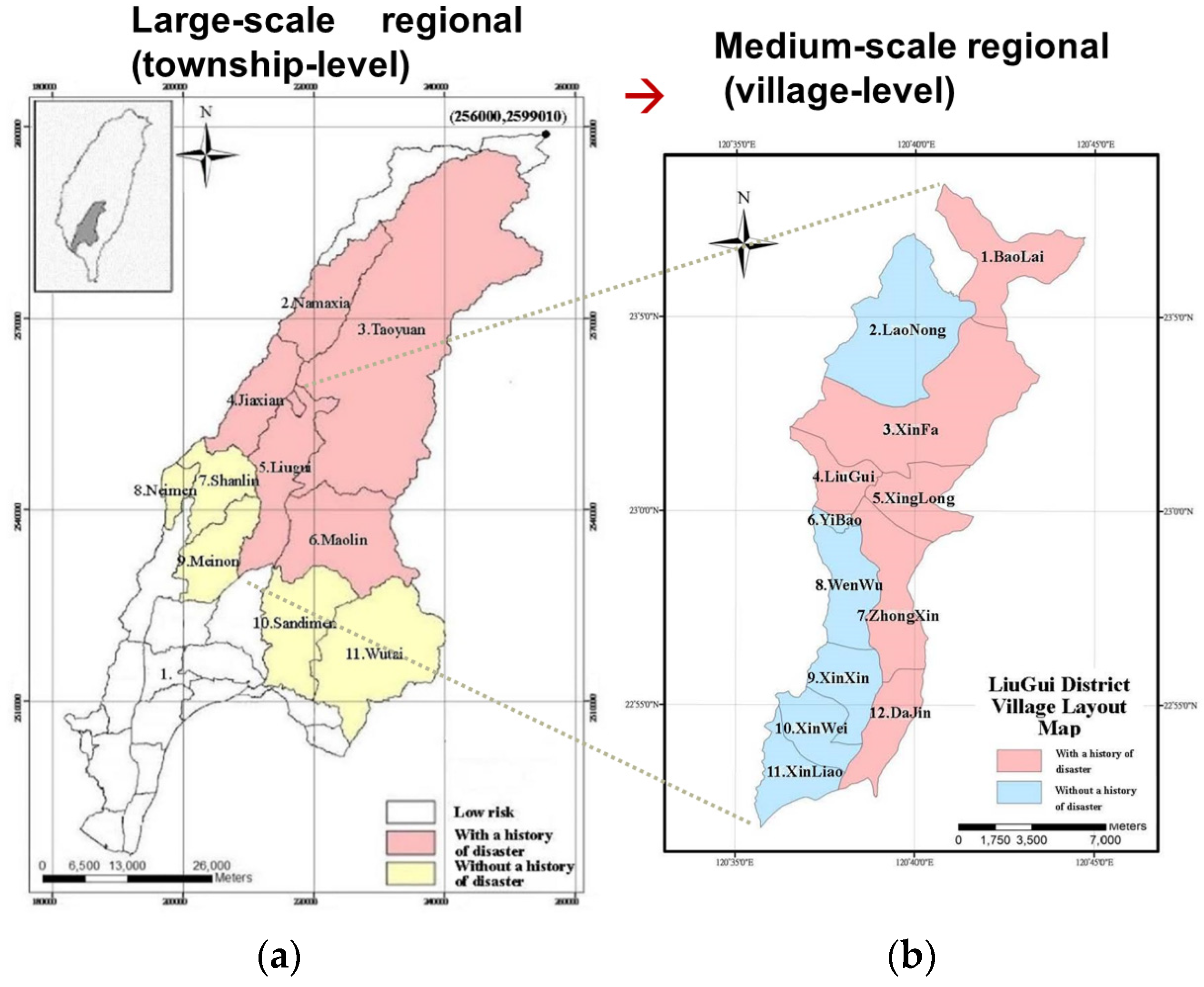
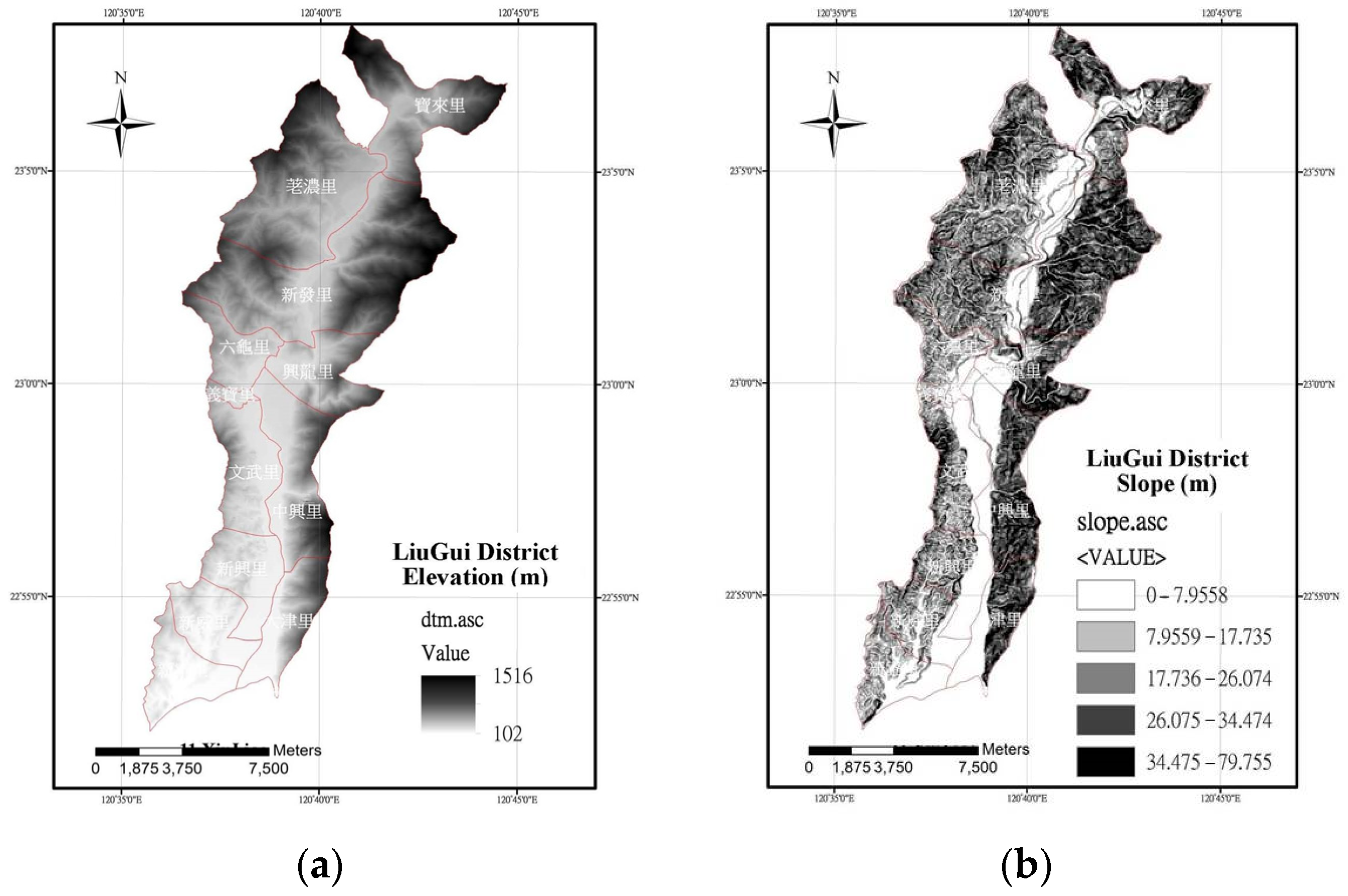
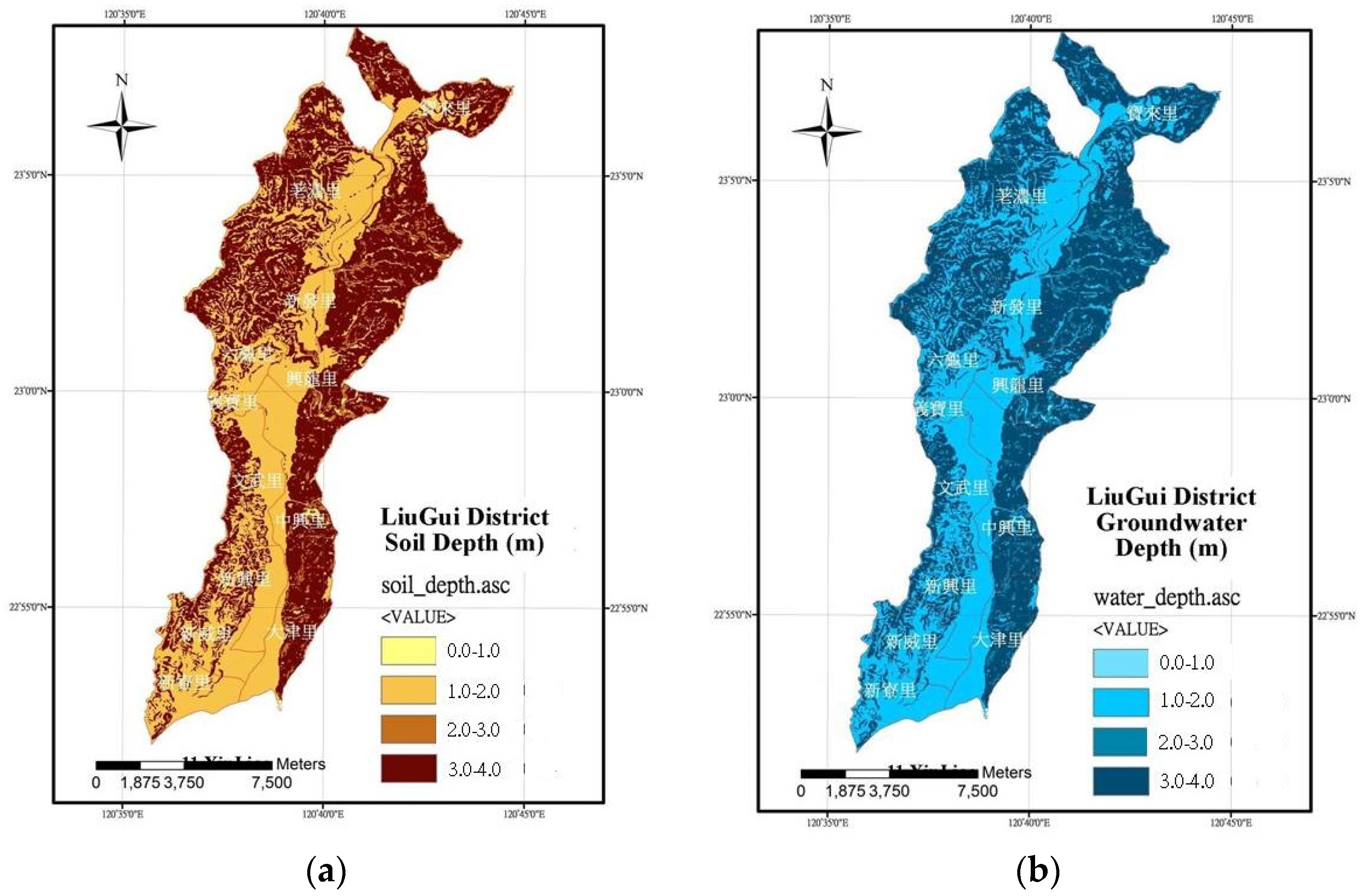
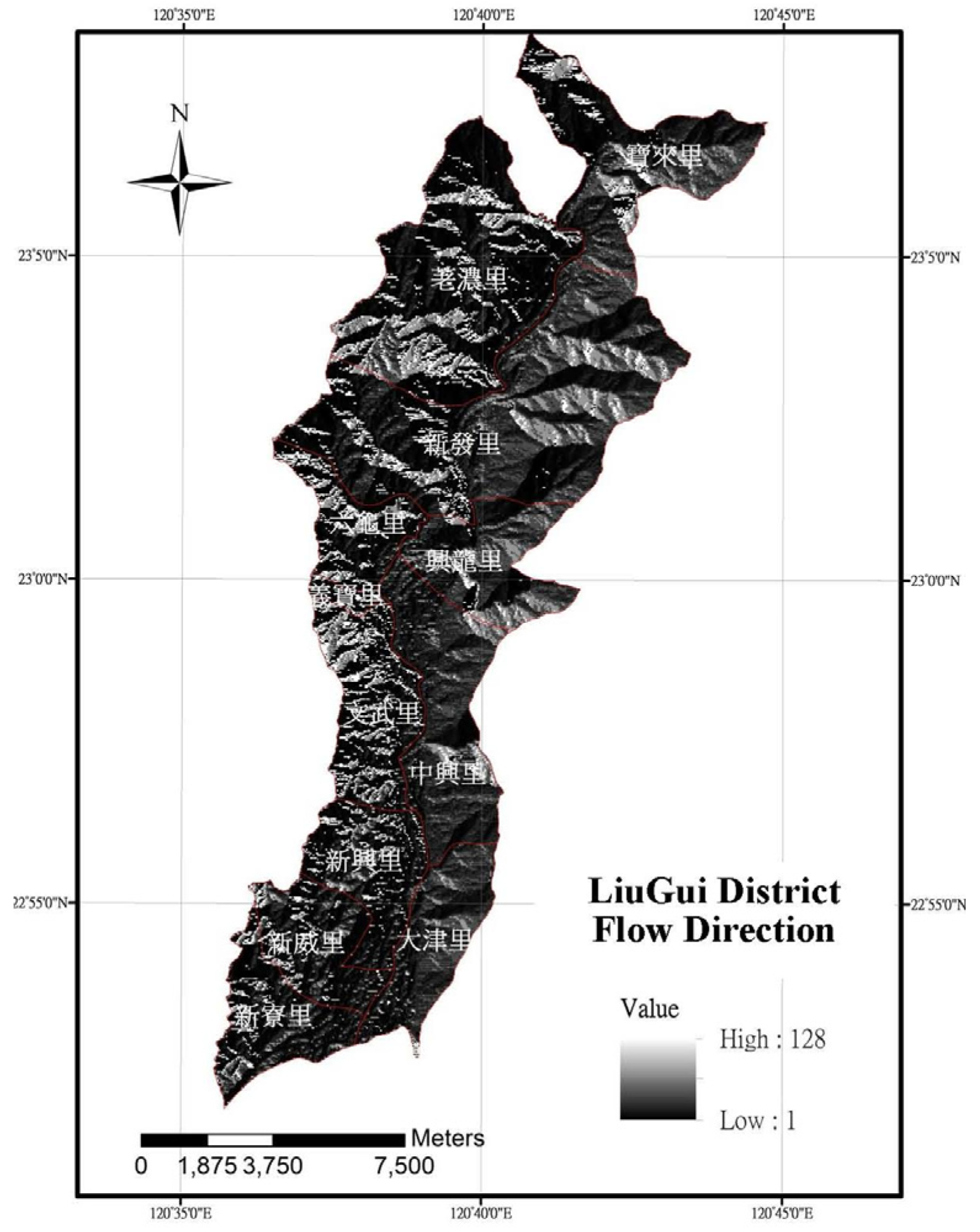
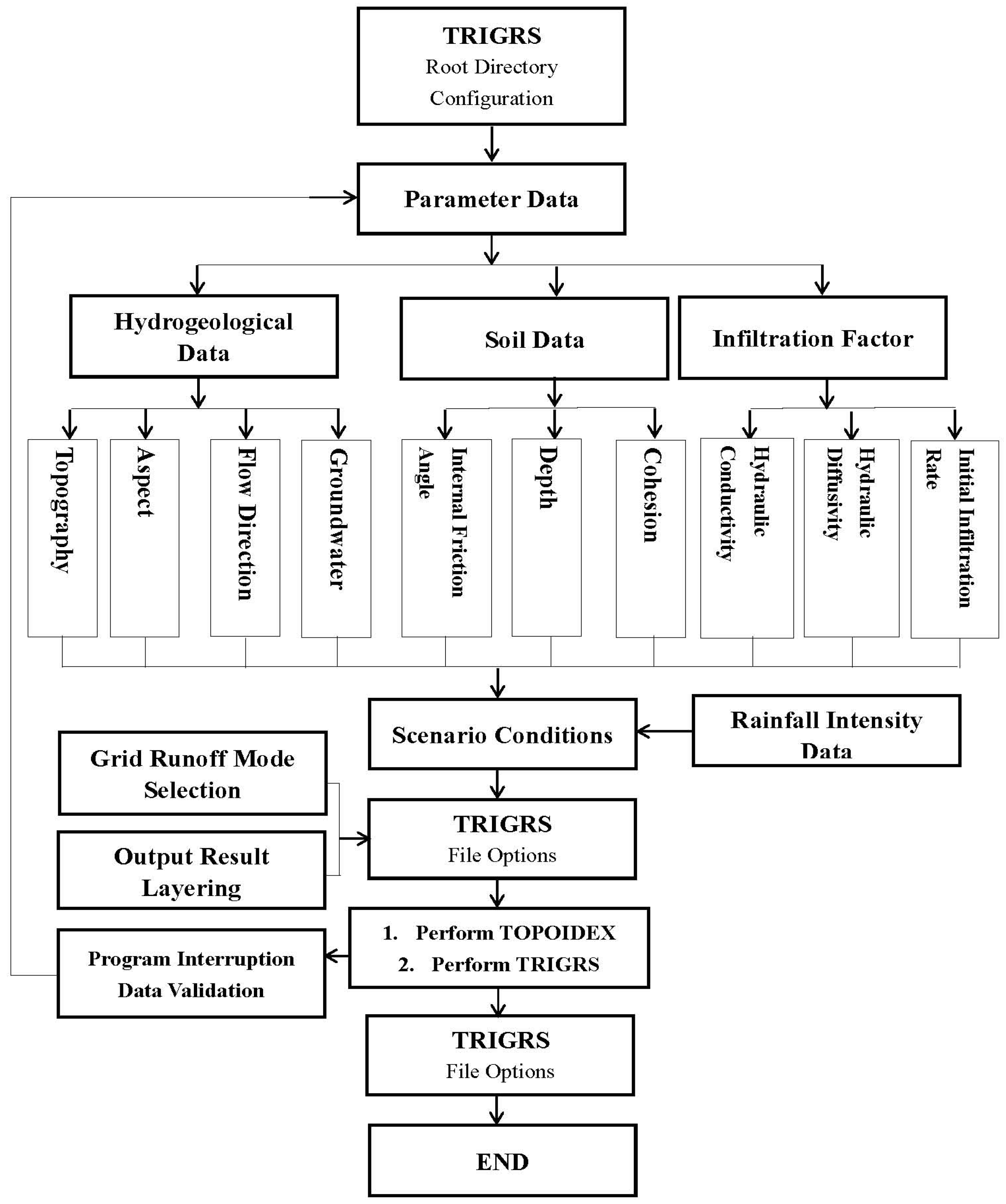
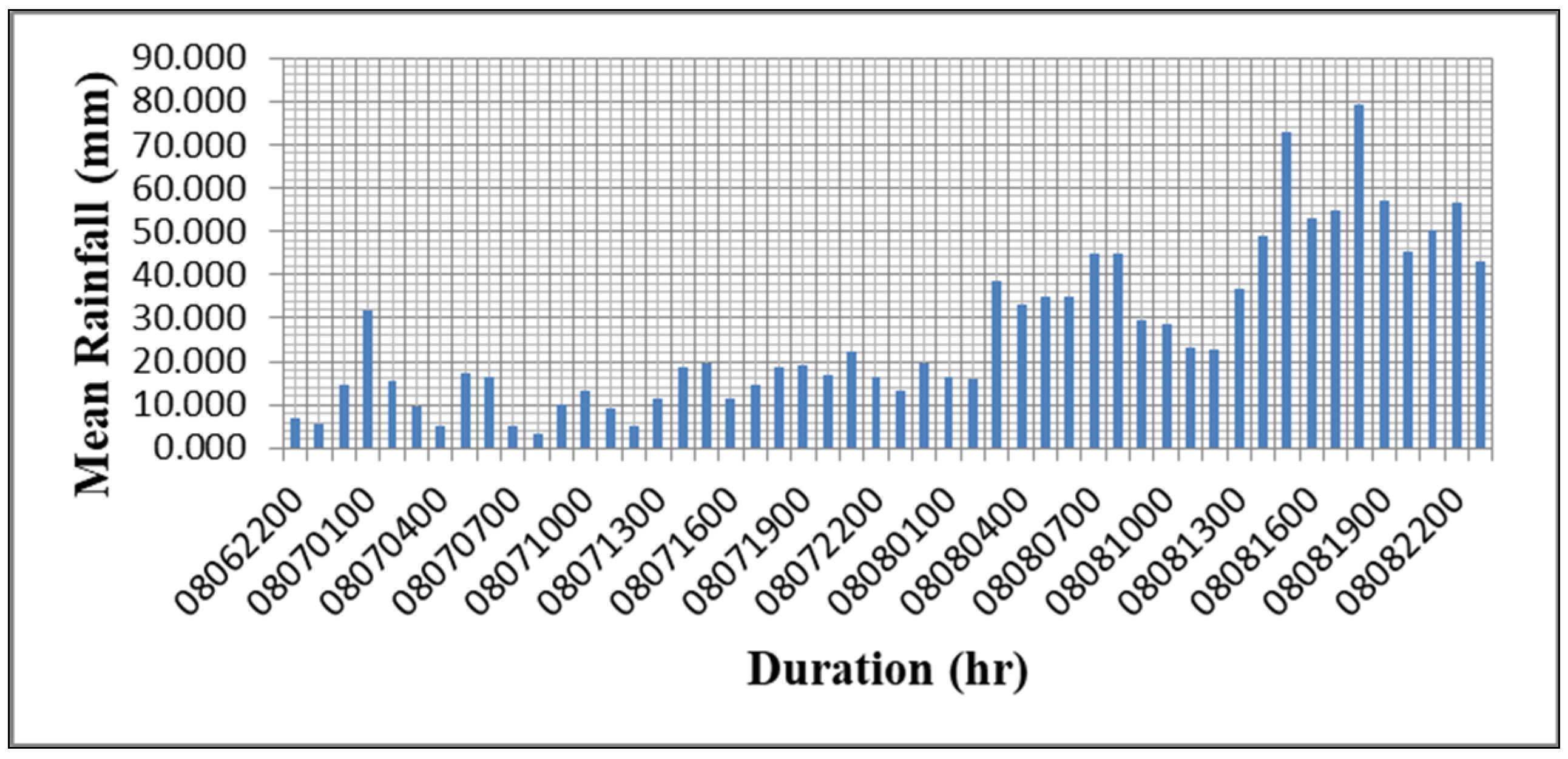

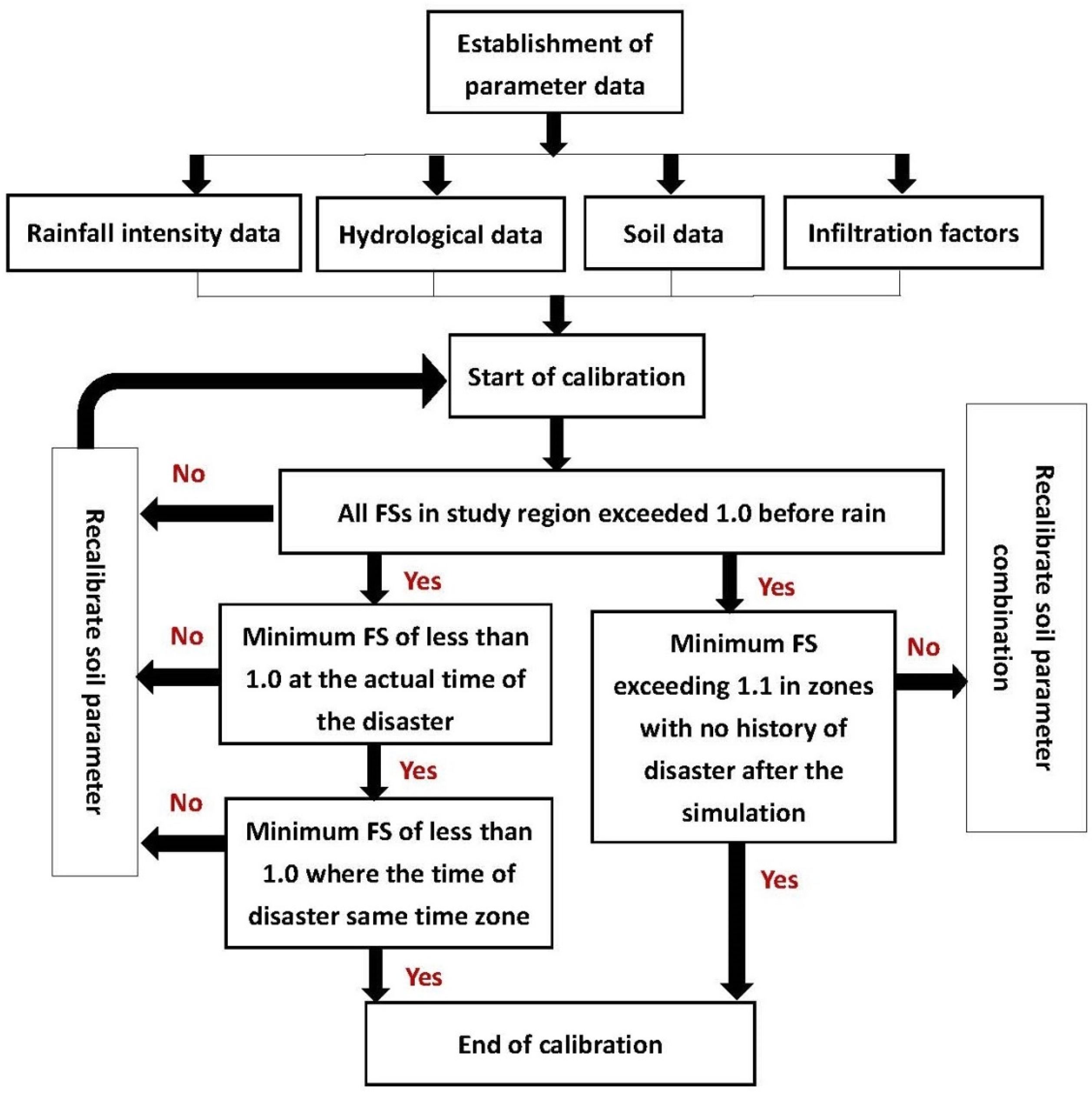
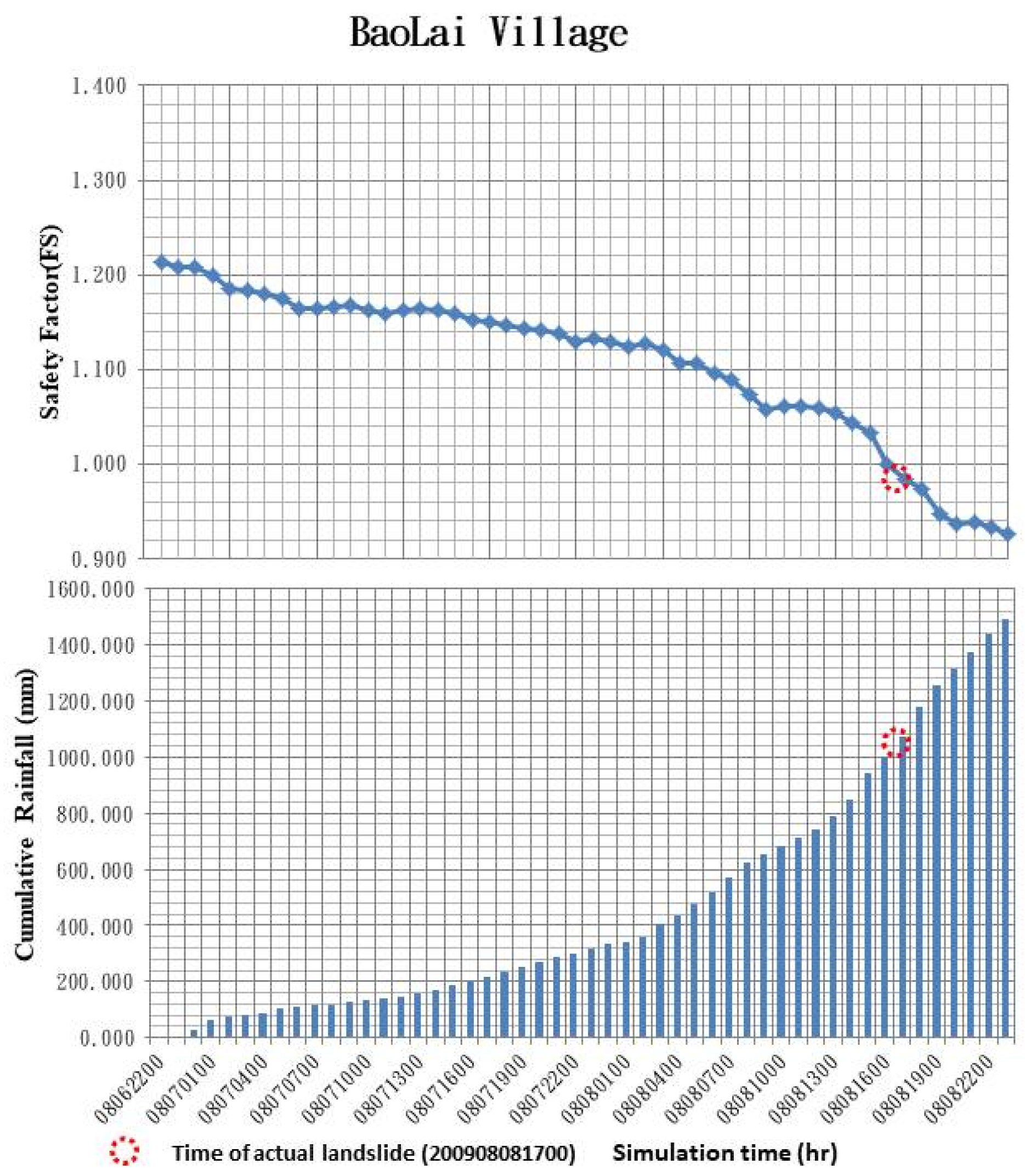
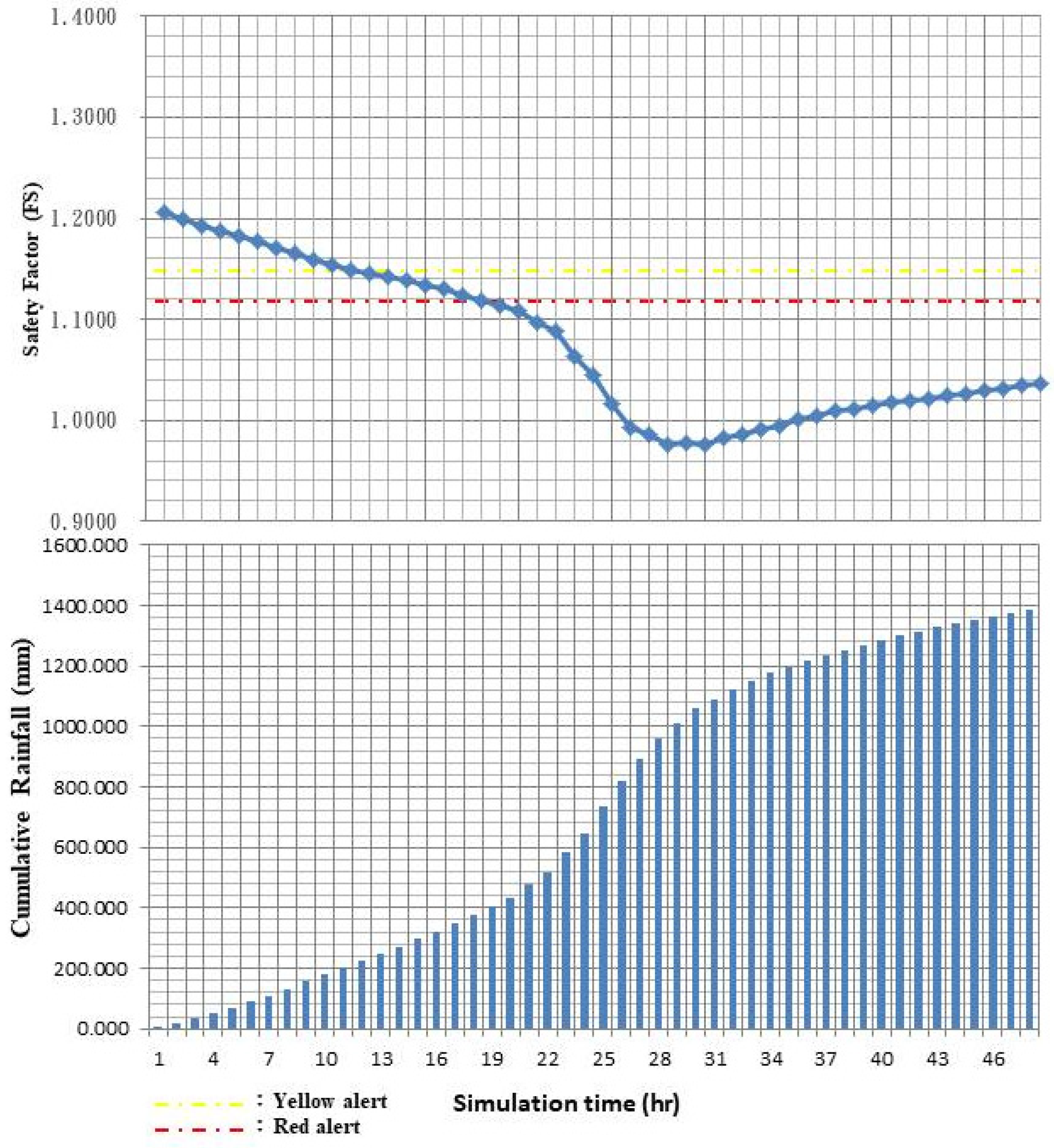
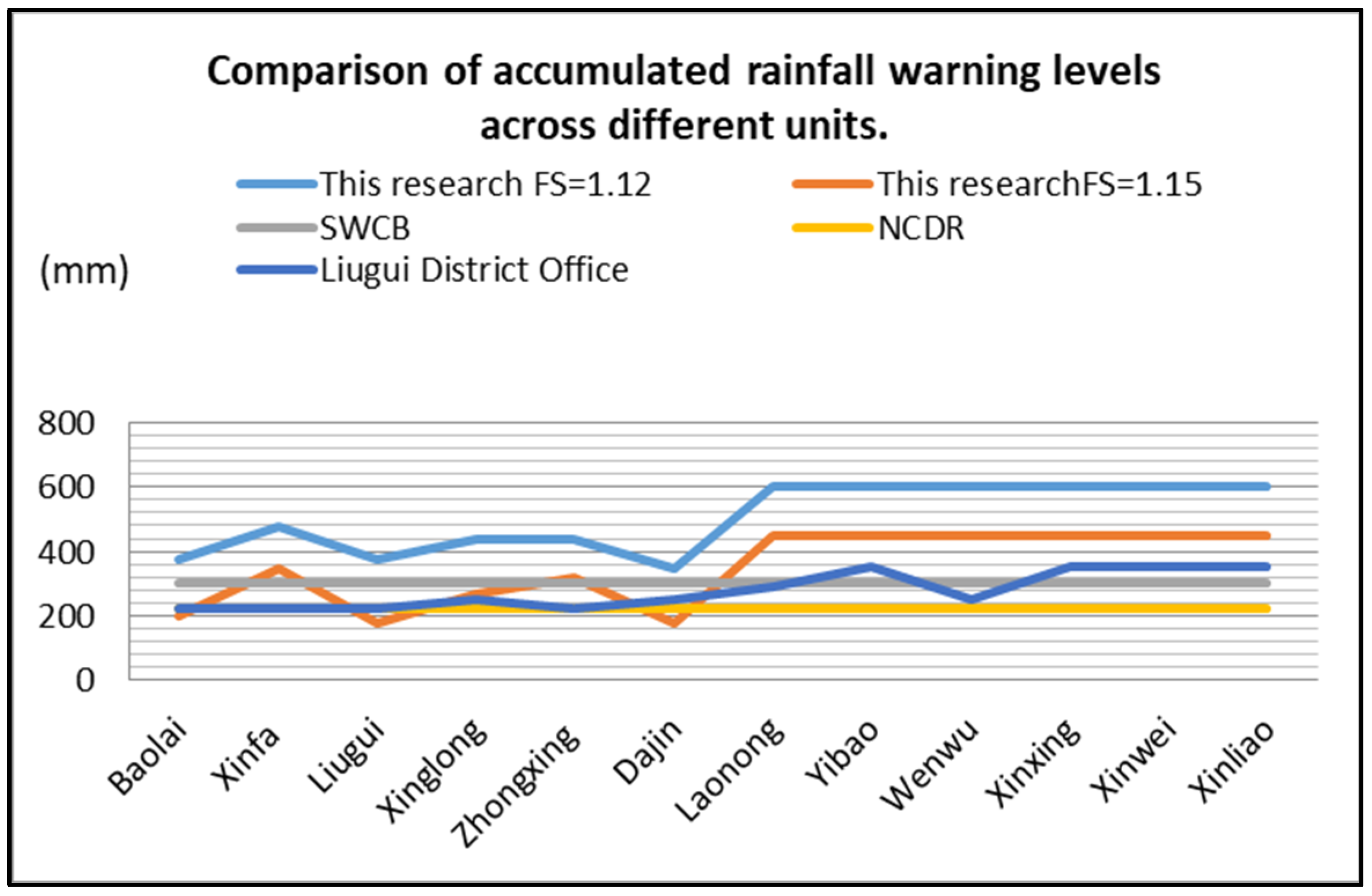
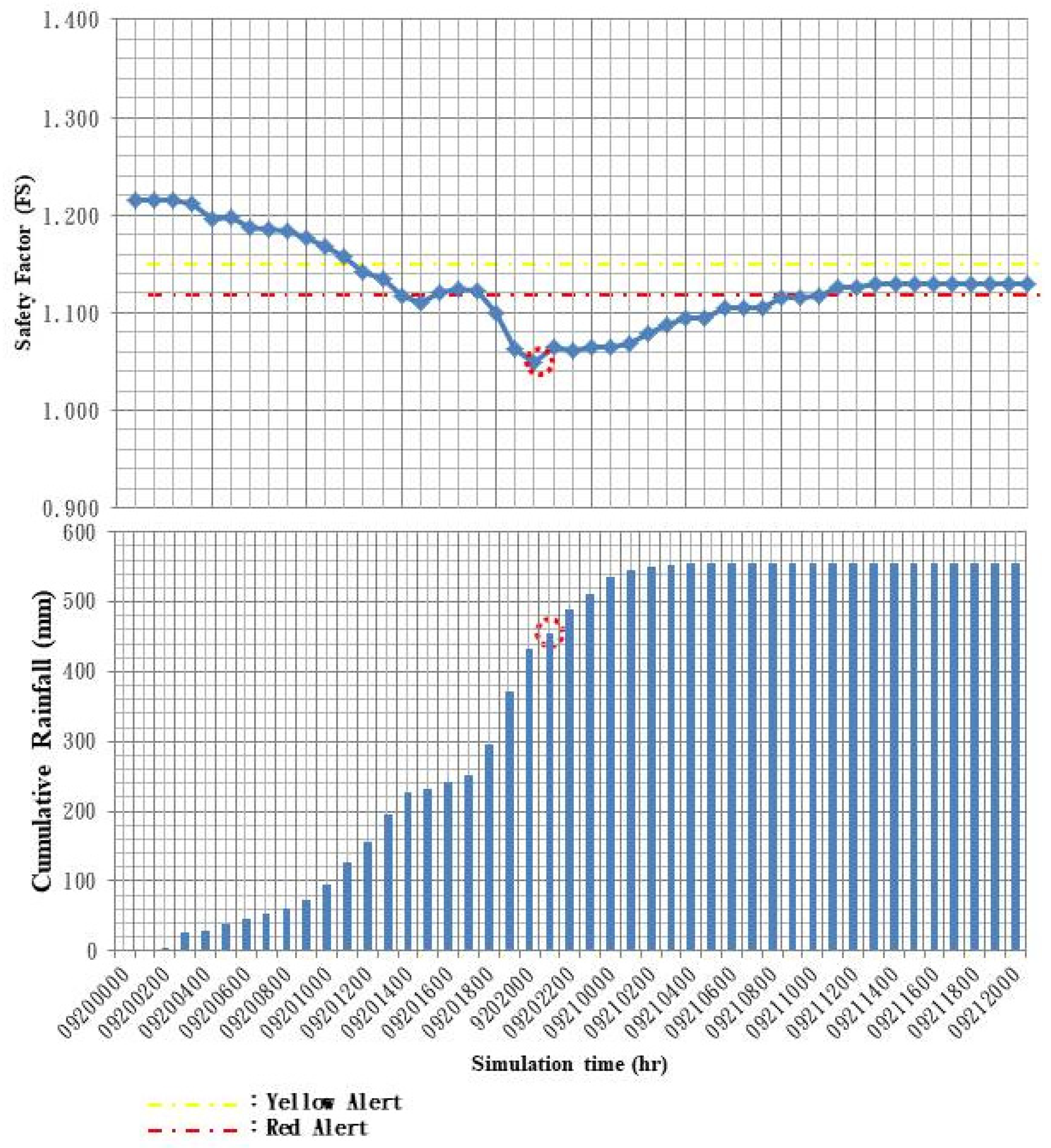
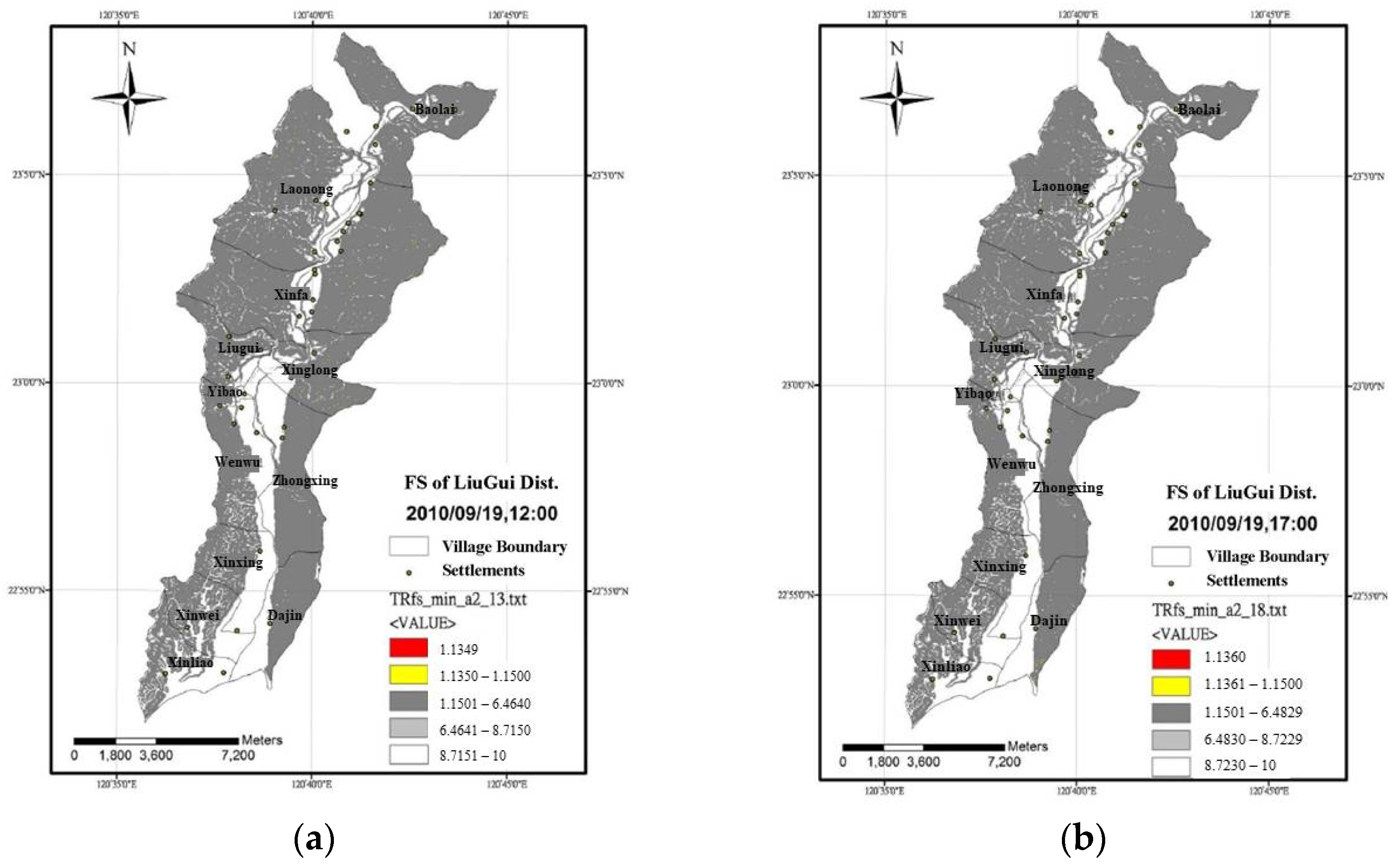
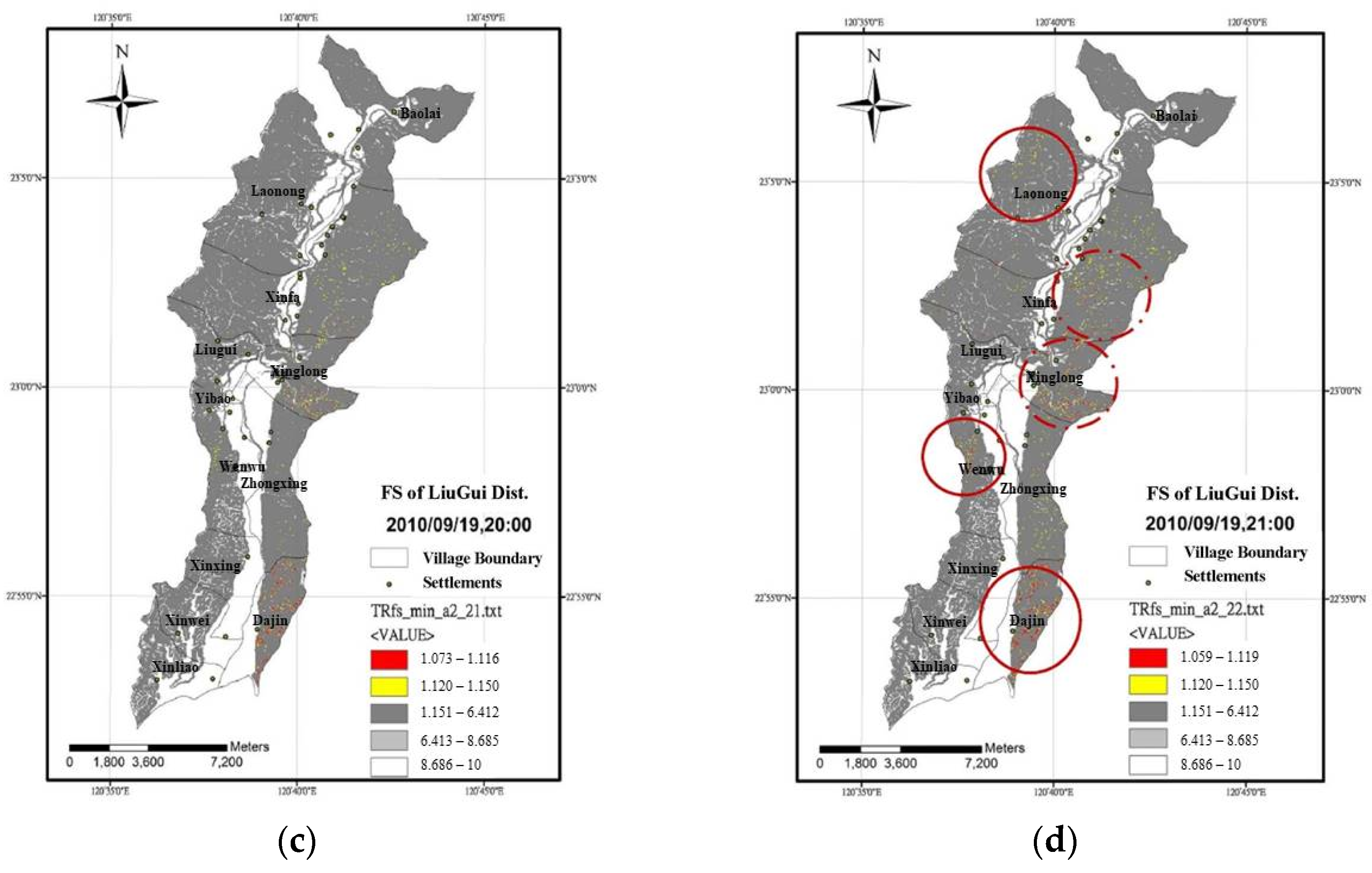
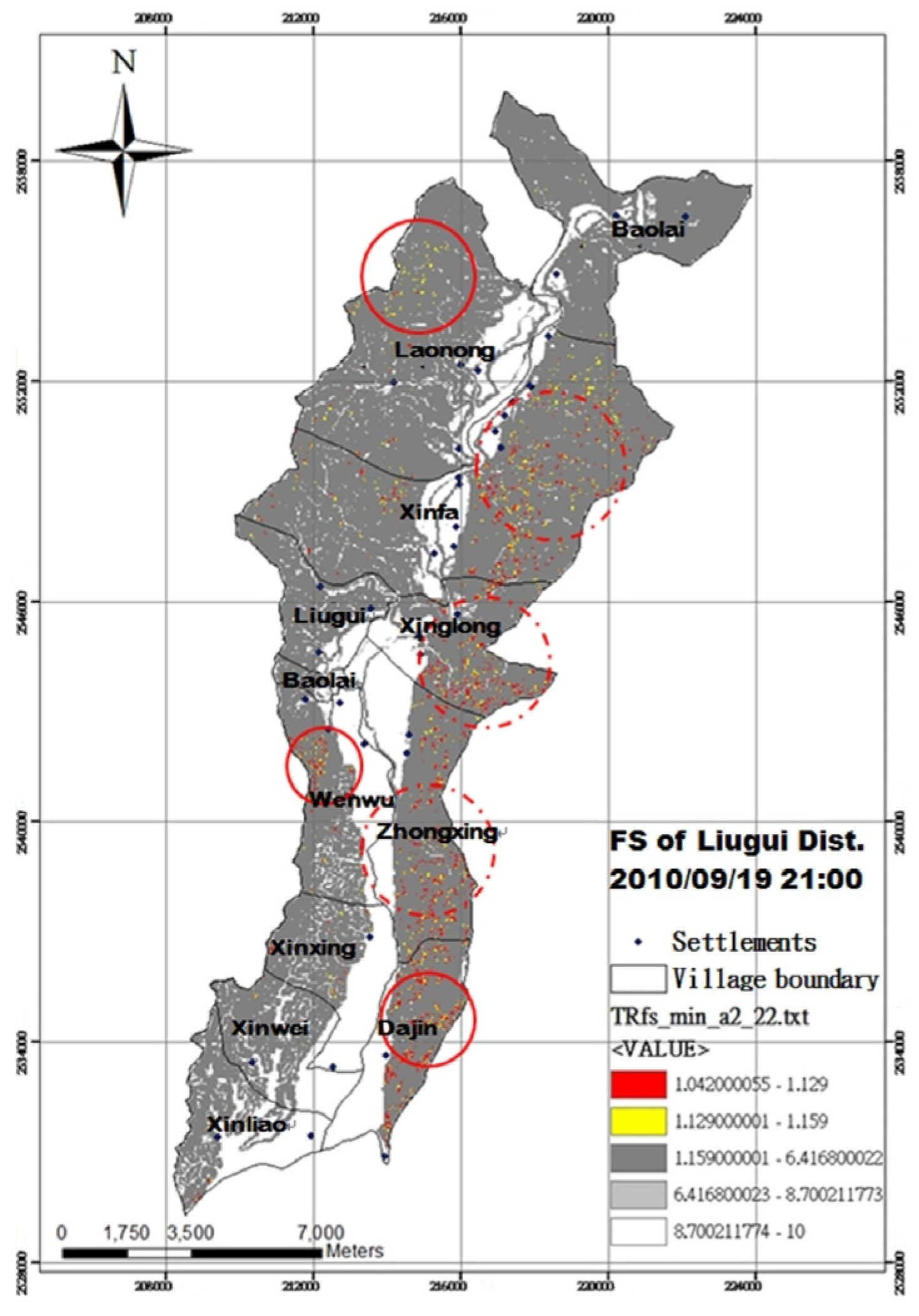
| Comparison Item | Statistical Methods | Deterministic Methods |
|---|---|---|
| Physical concepts | Part | Yes |
| Simplified calculation | Yes | No |
| Large amount of collapse data | Yes | No |
| Obtaining parameters | Easy | Not easy |
| Results possess spatial concepts | No | Yes |
| Easy acquisition of accurate results | No | Yes |
| Zone | District (Village) | Disaster Case | Zone | District (Village) | Disaster Case |
|---|---|---|---|---|---|
| 1 | Baolai | Yes | 7 | Zhongxing | Yes |
| 2 | Laonong | No | 8 | Wenwu | No |
| 3 | Xinfa | Yes | 9 | Xinxing | No |
| 4 | Liugui | Yes | 10 | Xinwei | No |
| 5 | Xinglong | Yes | 11 | Xinliao | No |
| 6 | Yibao | No | 12 | Dajin | Yes |
| Slope Degrees (°) | A (m) | B (m) | C (m) | Soil Depth (m) |
|---|---|---|---|---|
| <20 | 1.41 | 3.04 | 0.32 | 1.5 |
| 20–30 | 3.13 | 4.19 | 2.82 | 3.5 |
| 30–40 | 3.51 | 5.33 | 4.27 | 4.5 |
| 40–50 | 2.17 | 3.49 | 1.98 | 2.5 |
| >50 | 1.82 | 1.33 | 0.2 | 1.0 |
| Initial Groundwater Level Depth Estimation Method | References |
|---|---|
| Assume that the groundwater level depth is the same as the soil depth. | Chen [41], NCDR [40], Shih [42], Chien et al. [1] |
| Assume that the groundwater level is 50% of the soil depth. | Salciarini [31] |
| Calculate the initial saturation using the SINMAP model. | Ku et al. [44], Chen et al. [45], Chen et al. [46] |
| Use borehole groundwater level data and elevation regression formula. | Huang [4] |
| Parameter | Unit | Range | Methodology Adopted |
|---|---|---|---|
| Gradient | (°) | 0–53.9 | Calculated from a 40 × 40 m DEM |
| Depth of soil (Z) | m | 1–4.5 | Using the soil thickness table corresponding to slope by NCDR [40] |
| Effective cohesion (C) | Pa | 27,000 | Referencing the Central Geological Survey’s 2009 project Geological Survey and Database for Upstream Watersheds of Flood-Prone Areas (Phase 2, 2009)—Effect of Hydrogeology on Slope Stability [2] |
| Effective friction angle () | (°) | 29 | |
| Soil unit weight () | 22,000 | ||
| Saturated hydraulic conductivity (Ksat) | m | 5.5 × 10−5 | |
| Hydraulic diffusivity (diffuse) | 1.0 × 10−2 | ||
| Initial infiltration rate (Iz) | m | 5.0 × 10−9 | |
| Initial groundwater level (d) | m | 1–4.5 | Referring to Chen [41], NCDR [40], Shih [42], assuming that it is the same as the soil thickness. |
| No. | District (Village) | Simulation Time FS Dropped to 1.0 Time (h) | Simulation Time FS Dropped to 1.1 Time (h) | Simulation Time FS Dropped to 1.12 Time (h) | Simulation Time FS Dropped to 1.15 Time (h) |
|---|---|---|---|---|---|
| 1 | Baolai | 44 | 33 | 30 | 20 |
| 3 | Xinfa | 47 | 41 | 35 | 33 |
| 4 | Liugui | 44 | 33 | 31 | 22 |
| 5 | Xinglong | 42 | 31 | 29 | 21 |
| 7 | Zhongxing | 47 | 39 | 35 | 32 |
| 12 | Dajin | 36 | 29 | 23 | 14 |
| No. | District (Village) | Simulation Time FS Dropped from 1.1 to 1.0 Time (h) | Simulation Time FS Dropped from 1.12 to 1.0 Time (h) | Simulation Time FS Dropped from 1.15 to 1.0 Time (h) |
|---|---|---|---|---|
| 1 | Baolai | 11 | 14 | 24 |
| 3 | Xinfa | 16 | 12 | 14 |
| 4 | Liugui | 11 | 13 | 22 |
| 5 | Xinglong | 11 | 13 | 21 |
| 7 | Zhongxing | 8 | 12 | 15 |
| 12 | Dajin | 7 | 13 | 22 |
| No. | District (Village) | Time to Reach Red Alert when FS = 1.12 (h) | Time to Reach Yellow Alert when FS = 1.12 (h) |
|---|---|---|---|
| 1 | Baolai | 18 | 11 |
| 3 | Xinfa | 21 | 17 |
| 4 | Liugui | 18 | 10 |
| 5 | Xinglong | 20 | 14 |
| 7 | Zhongxing | 20 | 16 |
| 12 | Dajin | 17 | 10 |
| No | District (Village) | Disaster Case | Red Alert FS = 1.12 Cumulative Rainfall (mm) | Yellow Alert FS = 1.15 Cumulative Rainfall (mm) |
|---|---|---|---|---|
| 1 | Baolai | Yes | 374.14 | 203.06 |
| 3 | Xinfa | Yes | 474.66 | 347.12 |
| 4 | Liugui | Yes | 374.14 | 179.68 |
| 5 | Xinglong | Yes | 434.76 | 270.82 |
| 7 | Zhongxing | Yes | 434.76 | 320.10 |
| 12 | Dajin | Yes | 347.12 | 179.68 |
| No | District (Village) | Disaster Case | Red Alert FS = 1.12 Cumulative Rainfall (mm) | Yellow Alert FS = 1.15 Cumulative Rainfall (mm) |
|---|---|---|---|---|
| 2 | Lanong | No | 600 | 450 |
| 6 | Yibao | No | 600 | 450 |
| 8 | Wenwu | No | 600 | 450 |
| 9 | Xinxing | No | 600 | 450 |
| 10 | Xinwei | No | 600 | 450 |
| 11 | Xinliao | No | 600 | 450 |
| Zone Number | District Village | Category Case | This Research | SWCB | NCDR | Liugui District Office | |
|---|---|---|---|---|---|---|---|
| Red Alert in FS = 1.12 | Yellow Alert in FS = 1.15 | ||||||
| 1 | Baolai | Disaster | 374 | 203 | 300 | 225 | 225 |
| 3 | Xinfa | 475 | 347 | 300 | 225 | 225 | |
| 4 | Liugui | 374 | 180 | 300 | 225 | 225 | |
| 5 | Xinglong | 435 | 271 | 300 | 250 | 250 | |
| 7 | Zhongxing | 435 | 320 | 300 | 225 | 225 | |
| 12 | Dajin | 347 | 180 | 300 | 250 | 250 | |
| 2 | Laonong | Non- disaster | 600 | 450 | 300 | 250 | 290 |
| 6 | Yibao | 600 | 450 | 300 | 350 | 350 | |
| 8 | Wenwu | 600 | 450 | 300 | 250 | 250 | |
| 9 | Xinxing | 600 | 450 | 300 | 350 | 350 | |
| 10 | Xinwei | 600 | 450 | 300 | 350 | 350 | |
| 11 | Xinliao | 600 | 450 | 300 | 350 | 350 | |
| No. | District | Simulation Time When FS Reaches 1.0 (h) | Simulation Time When FS Reaches 1.12 (h) | Simulation Time When FS Reaches 1.15 (h) |
|---|---|---|---|---|
| 12 | Dajin Village | 22 | 16 | 13 |
| No. | District | Time Duration from FS 1.12 to the Occurrence of Landslide (h) | Time Duration from FS 1.15 to the Occurrence of Landslide (h) |
|---|---|---|---|
| 12 | Dajin Village | 6 | 9 |
| No. | District | SWCB Simulation Time to Reach Warning Accumulated Rainfall Value of 300 mm (h) | NCDR Simulation Time to Reach Warning Accumulated Rainfall Value of 225 mm (h) |
|---|---|---|---|
| 12 | Dajin Village | 19 | 15 |
| No. | District | SWCB Time Interval from Warning Issuance to Actual Disaster Occurrence (h) | NCDR Time Interval from Warning Issuance to Actual Disaster Occurrence (h) |
|---|---|---|---|
| 12 | Dajin Village | 3 | 7 |
Disclaimer/Publisher’s Note: The statements, opinions and data contained in all publications are solely those of the individual author(s) and contributor(s) and not of MDPI and/or the editor(s). MDPI and/or the editor(s) disclaim responsibility for any injury to people or property resulting from any ideas, methods, instructions or products referred to in the content. |
© 2023 by the author. Licensee MDPI, Basel, Switzerland. This article is an open access article distributed under the terms and conditions of the Creative Commons Attribution (CC BY) license (https://creativecommons.org/licenses/by/4.0/).
Share and Cite
Hsu, C.-F. Rainfall-Induced Landslide Susceptibility Assessment and the Establishment of Early Warning Techniques at Regional Scale. Sustainability 2023, 15, 16764. https://doi.org/10.3390/su152416764
Hsu C-F. Rainfall-Induced Landslide Susceptibility Assessment and the Establishment of Early Warning Techniques at Regional Scale. Sustainability. 2023; 15(24):16764. https://doi.org/10.3390/su152416764
Chicago/Turabian StyleHsu, Chia-Feng. 2023. "Rainfall-Induced Landslide Susceptibility Assessment and the Establishment of Early Warning Techniques at Regional Scale" Sustainability 15, no. 24: 16764. https://doi.org/10.3390/su152416764
APA StyleHsu, C.-F. (2023). Rainfall-Induced Landslide Susceptibility Assessment and the Establishment of Early Warning Techniques at Regional Scale. Sustainability, 15(24), 16764. https://doi.org/10.3390/su152416764






